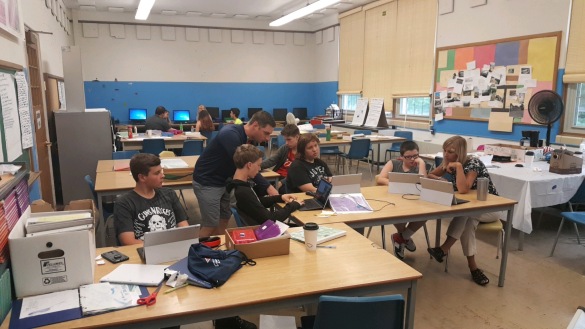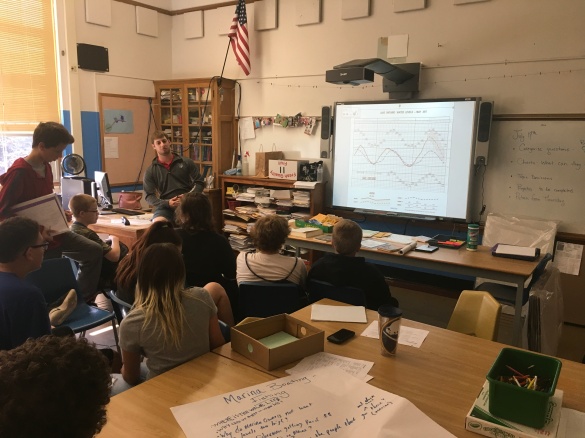Whether planned or not, there is a common thread running through the work of the past two summers, and what I’m seeing in our summer project at the middle school. The umbrella question is essentially, “Who is doing the work?” I’ve participated in a few final interviews that our superintendent has with prospective hires. His message to them in terms of performance and evaluation is this: Years ago, observers would enter a classroom and focus on what the teacher was doing. Now, their notes reflect what the kids are doing more than the instructor. Such a distinction.
Our professional development work in math that began last summer helped to put my mind on that path. Starting the class (math in this case, but true for all) with something that ALL kids can do is key…and not impossible. The name of the consultant company working with us, Access Mathematics, makes sense. It’s about making this subject open to all. Accessible. So, rather than starting the class with a word problem as a warm-up and having the students answer it, start by having them read, think, notice, and wonder about it. All can do that. Then share those thoughts with a partner. Take off the question stem so they’re not so focused on the answer. Have them develop their own questions. Listen to their answers, and use that info (plus a little of your own expertise) to drive the lesson forward. As work turns to paper and pencil (other tools of expression ok as well), resist the urge to take the pencil from the students hands and instead, ask questions…wait…letting the students grapple with an answer. There’s so much more than that, but at its essence, it’s about what the kids are doing.
Fast forward a year to this summer. In addition to work with Access Mathematics, we’ve had the opportunity to again learn the fine art of Writers Workshop with Amy Ludwig Vanderwater. A foundational element of the workshop is convincing the kids that they are all writers, and to treat them as such. Maybe it’s really about treating them as writers in order to convince them that they are. Anyway, the conferring aspect is huge. The one-on-one conversations between teacher and writer…powerful. Similar to the math anecdote above, the adult needs to fight the urge to take the writer’s pencil. Keep it in the kid’s hand…ask questions to probe their thinking. Don’t tell them what a great conclusion would be but give them strategies to develop one on their own. Waiting is ok. Silence is ok. Independence is being built, even though the work is not perfect. Accept the fact that growth of independence comes in stops and starts…but for it to be the learner’s growth, we can’t do the growing for them.
Which brings me to the summer program (the Rising Tide entries). I just had a 40 minute or so discussion with the program’s coordinator. The struggle with uncertainty…our desire that kids grow…the competing desire to direct the kids’ time…what does growth look like? What does a finished product look like?
The thread that connects us in all that we’re doing is the specific desire to have the kids own more of their learning. And they own it by doing it. By doing the math, doing the writing, doing the thinking, their connection with learning and their capacity for learning will increase. There are all sorts of subjects in any school…the connecting thread is “who is doing the work,” because the one who does the work is the one who will grow. So instead of giving answers, ask questions. Instead of the passive acquisition of knowledge, it’s the active use and application of that knowledge.
This week, like for so many of you, has been busy. Interviews, conferences…our summer program has been in the caring hands of other adults, but not one. I did stop up for a bit today. Here’s what I witnessed.

See the kids in the back? They’re working on invitations for the evening program to present their findings on Lake Ontario water levels. The kids in the front? Their learning the software needed to put their book/final project together. In another room, a third group is making a sign and flyers advertising our presentation. Another is creating a time capsule of this year when the lake levels reached such epic heights. See the bulletin board? That’s the rough draft of the book which will be (self) published. Two of the students shown have struggled mightily with growth. Others have been amazing on a daily basis. The thread goes through this room too. We’ll walk out of this room next week knowing that many of the kids have done the work. Some have demonstrated this by being here every day. Some have shown it by responding to correction positively. Some have stumbled, some have moved forward each day. The focus has consistently been on the kids….the kids doing the work…the kids asking the questions…and finding ways to answer.
There’s nothing perfect about the work being done. It’s a nervous group of learners and adults, riding a wobbly tandem bicycle, tentatively trying, failing, and succeeding. The thread runs through each subject and skill, and each of us who engage in this work.
 July 17, 2017
July 17, 2017